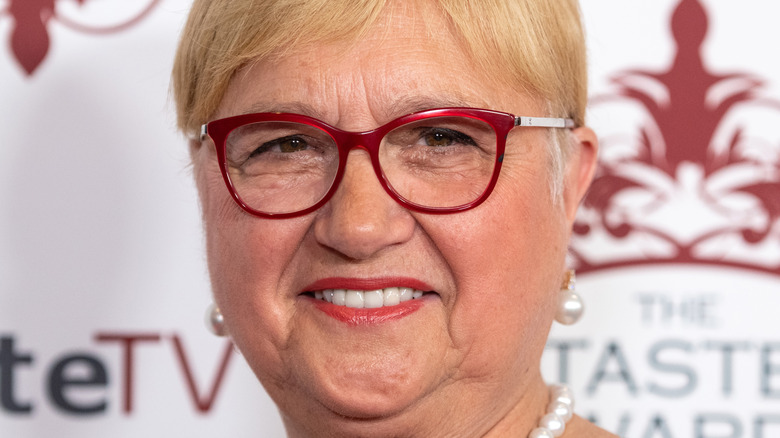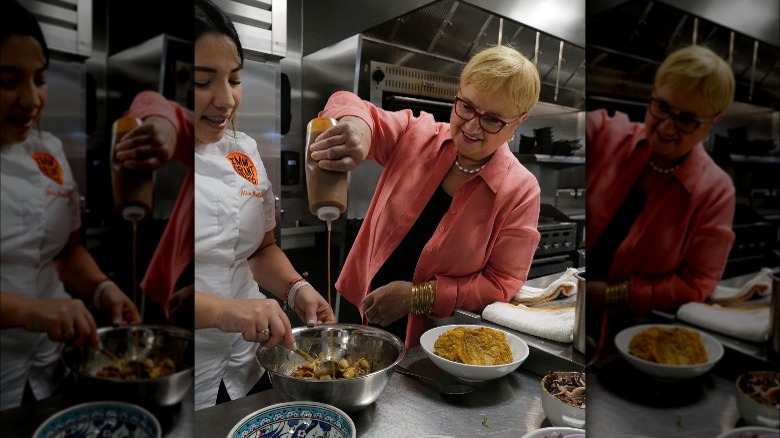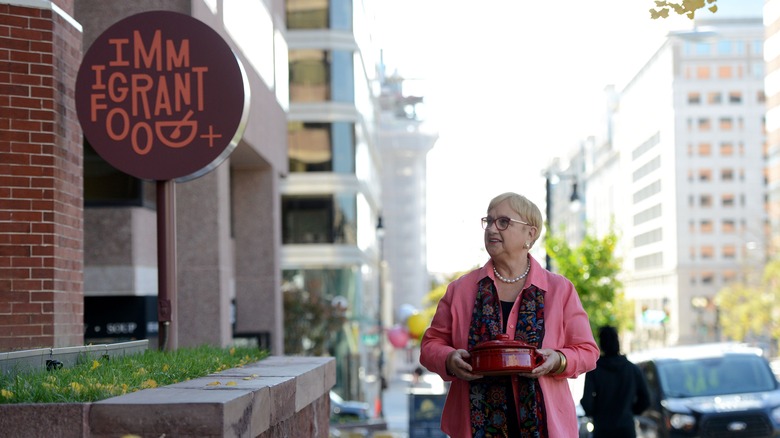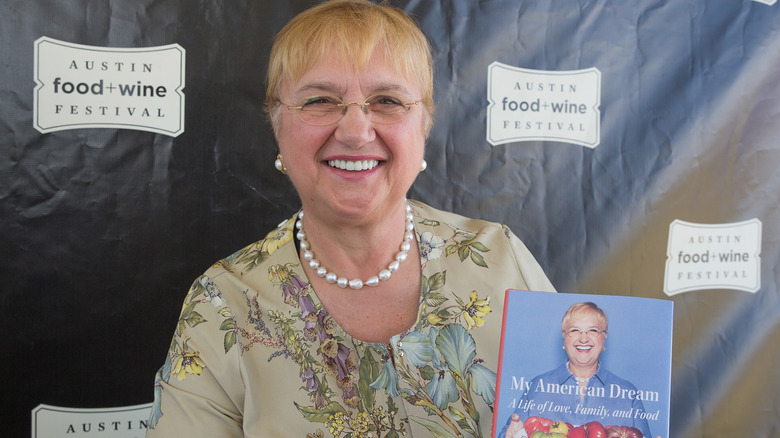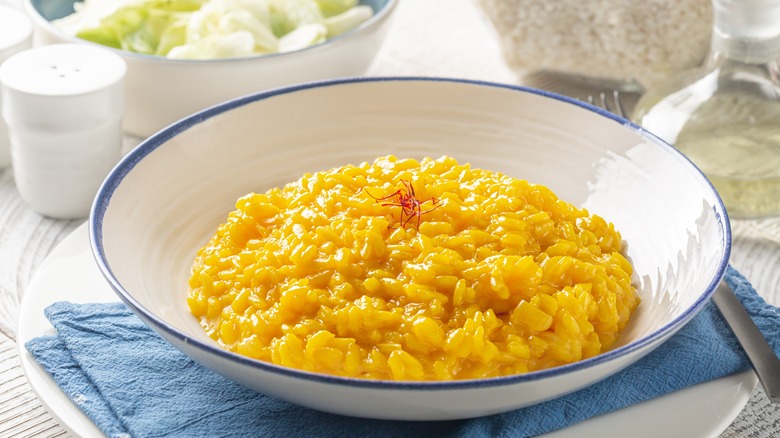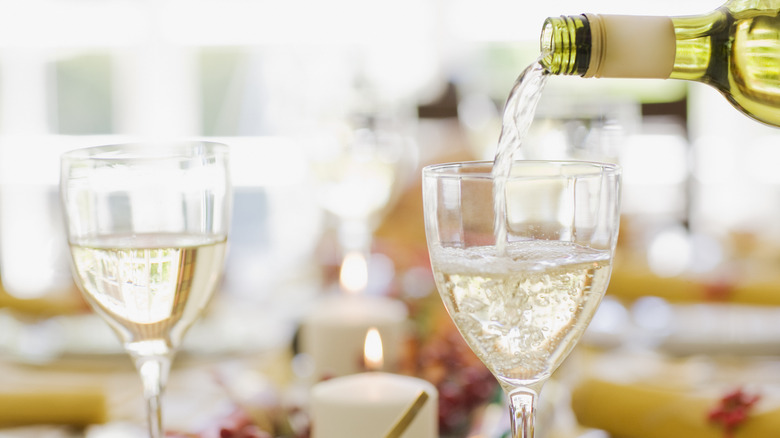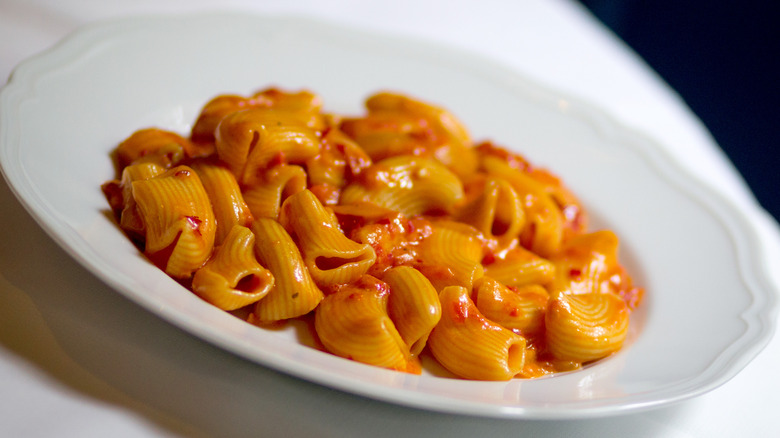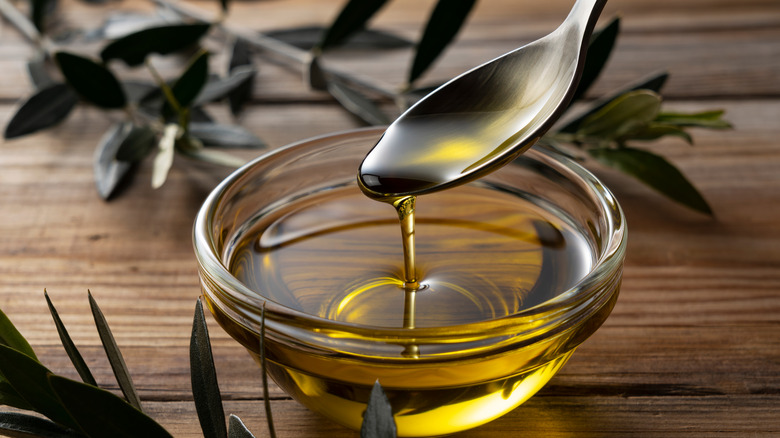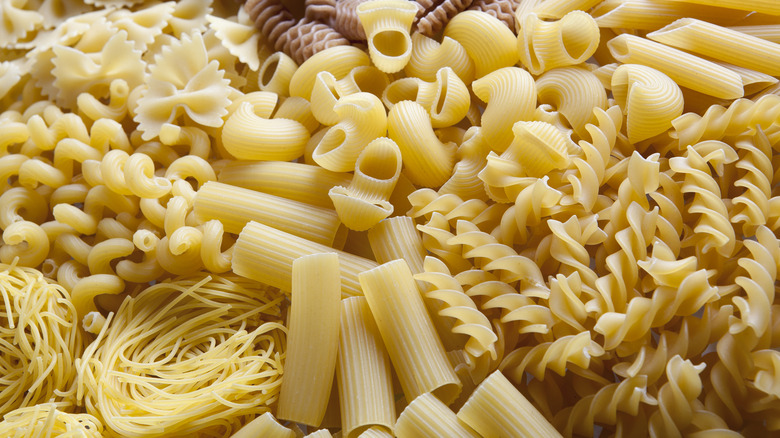Lidia Bastianich On Her Italian Immigrant Roots, Cooking Tips, And A New PBS Special - Exclusive Interview
Cookbooks, television shows, holiday specials — Lidia Bastianich has done it all. The celebrity chef has found success through her passion for Italian American food, ultimately leading to several restaurants, "Lidia's Kitchen" on Amazon Prime, and now, a PBS special. Bastianich's newest endeavor, "Lidia Celebrates America: Flavors That Define Us," highlights the journeys of immigrants to the United States through cultural recipes and honorable kitchen traditions.
The cooking star is an immigrant herself, having settled in North America as a young child after fleeing from Yugoslavia to Italy. Since then, Bastianich's love for the culinary world has influenced Italian American cuisine in more ways than one — like when she introduced risotto alla Milanese to the States (thank you very much, Lidia!). In a heartwarming interview with Tasting Table, the food mogul revealed exactly what it was like to leave her home country and connect with other immigrants. She also divulged some helpful cooking tips — such as how to choose the best boxed pasta at the supermarket.
Lidia views food as non-threatening
We're here to talk about your new PBS special, "Lidia Celebrates America: Flavors That Define Us." What was your biggest inspirational takeaway from filming this special?
I'm an immigrant, and [when] I came here, I was 12 years old. In these times, the problems of immigrants are not understood, not appreciated, not handled properly by the government, by individuals, by different parties. All of that concerned me because I am the product of being an immigrant, coming to America, [and] being accepted and given the opportunity to develop, be free, [and] have my family grow here.
I thought, "Let me go around," because this is my 13th special. "Lidia Celebrates America" is really about that — me celebrating this country, which I think is wonderful. How do I thank this country? I have my cooking show, and that's part of who I am, but this is specifically discovering and sharing with America things that America doesn't see. As an immigrant, I got to get in there and tell America, "I'm an immigrant. Look at me. America accepted me, welcomed me, and look what I did."
On the other hand, it's very important — and sometimes it's missed by the immigrants themselves — to show appreciation, to give back once they're made ... [America] is a patchwork of different ethnicities that makes America great.
Through meeting all of these amazing people, is there a dish they showed you that stands out in your mind?
Food is welcoming. It's non-threatening. I feel I can slide into someone's home, someone's table, someone's life, someone's culture. I'm interested [in] what they do [and] how they do it. [It was] even amazing to eat with them [and see] how they eat. Different cultures eat differently — some on the floor, some with their hands. Eating in their setting, one [might] say, "Oh my God, do you grab food with your hands?" But when you are eating it within that setting of that culture, there's a meaning to it. There is a connection to it. I love touching food. For me to eat actually with my hands, I love. That's my innate need or want, to touch food. ...
It was getting into people's lives through food, and then discovering everything else, because then they had confidence. They felt comfortable with Lidia, and I felt comfortable with them. Every culture was different. Chinese was completely different, then we go to Afghanistan and [see] all of their foods, then the borscht from Ukraine — all completely different. I was aware of those nuances, but working with them was quite interesting.
The hard truths of immigrating to another country
Is there a kitchen tip that you learned from the immigrant people you filmed with that you use today?
You always learn something, because whatever your profession is, continuing to learn keeps you alive and on top of it. ... You see something and [think], "Oh, I can do this with this." How do you [incorporate] some of these [ideas] into yours? What I found very interesting [was] the different flatbreads they all made. There were tacos, or there was the Indian fry. Every culture has some form of flatbread. Along the way, it was interesting to find how the flatbread is made and used at the table. As an Italian, we need our loaf of crunchy bread, even though we have focaccia and whatever, but in other cultures, unleavened bread is quite important and popular.
At a young age, you fled to Italy from Yugoslavia before coming to America. What was it like to be able to connect with people who had a similar experience as you?
It was great. The basic [question is] — and it's always heartwarming — what are the needs and the desires? What is an immigrant looking for? It's so hard to leave one's home, everything you've ever known. ... To leave all that behind to go into the unknown, that's a very difficult move to make, especially if you're an adult, you have a family, [and] you're taking your children to an unknown. An immigrant [may be] confused, sad, and nostalgic. Then you have to have positivity and look [to] the future.
All immigrants [have] this desire to have a safe, peaceful place [where] you can coexist with your own kind, but also, you become part of a bigger, enormous whole, which is America. The challenge [is] getting into that energy and developing your own energy within that energy. [You have] hopes of education for your children. You have this vision. [You have] hopes of having a job [and] a home where you can close [your door]. I was in the camp [for] two years, so I wanted a door to shut so we [could] be a family someplace all together [and] you don't feel open to all the elements all the time.
It all starts with Lidia's grandmother
How did those experiences foster your relationship with food?
My connection with food goes way back. In Italy, when the part of Italy [where] I was born became communist, everything was restricted, [including] food. My mother and my father — we lived in a little city — put us with my grandmother on the farm, because they had chickens [and] goats, so that promised a little more food. It was this basic essential of lacking food or being afraid of not having enough and helping Grandma in the production of this. I realized that [by] milking that goat, I could make ricotta, and I did make it with Grandma. [I learned about] harvesting the eggs of the chicken, the geese, and all these basic things that as a kid you never see. Those animals were to be respected and treated and fed well, because ultimately, they kept us alive.
[There was also] the whole garden and the planting of the potatoes and the wheat. She planted everything, all the [basics] that we needed to survive. We would harvest and shell the beans and save [them] for winter. She would lie [the potatoes] in a corner in the cantina, and that was for the whole winter stash. My grandfather — we had grapes. He made a little wine but ... would [also] let [them] hang so the air would dry [them] and we would get raisins. When Christmas came, we had raisins. We had nuts. The nuts got saved and dried, and that's what the Christmas feast was [made] with. I was involved in the seasonality, in the growth, in the production.
When my parents decided to escape back into Italy, [they didn't tell] us kids. We had relatives on the other side [whom] we went to visit. My father had to stay behind because they wouldn't allow the whole family to go. Once we were in Italy with this great aunt, my father escaped the border and caught up with us in Trieste. When he came, we realized that was it; we [were] not going to go back. So not having said goodbye to Grandma was very, very hard.
That drive to retain those memories, those flavors, and those aromas ended up in cooking. I loved cooking, just like Grandma, to get the aromas [of] the fresh bay leaves, the rosemary. Cooking brought me back to that period and gave me comfort, and I loved it. I did it then forevermore. I did it for my family. Cooking for me became the basic connector, the sharing of love, the nurturer. As you go on, reinforcement makes you grow. I know I can cook well, open a little restaurant, and people loved it. Economically, I did well. Then my books — people loved them. I was able to communicate that passion. And the TV show — one [thing] leads to another, but it all is a basic connection of understanding food, getting the techniques, and nurturing and feeding other people, [which] feeds you back.
The key to risotto alla Milanese is the rice
You brought risotto alla Milanese to America ... Is there a key to the perfect risotto, whether it's an ingredient, cooking technique, seasoning, et cetera?
Risotto is mostly about technique. You have to have the short-grain rice, the carnaroli or arborio, because that releases the starch and makes it creamy. Then you have to go through the process of toasting, cooking, and coaxing that starch out of the rice, and that's in the technique. [Toast] the rice, then slowly [add] a flavorful, hot stock, and continue rather than pouring the whole liquid in there and letting it cook like soup. All of that is a technique that makes the result creamy. The last step [is] mantecare, where you whip up a little bit of butter and cheese, and that brings everything together.
Risotto is simple in [the] sense that one cup will yield two cups of risotto and will take about three cups of liquid to get there, and about 14, 15, 16 minutes. Like pasta, you can make it very diverse. You can flavor it any way you want. It's a carrier; it's a starch; it takes on the flavors. Also, it's a filler. In countries where there's not a lot of meat and not a lot of protein, fillers like pasta, rice, [and] polenta [are] what Italians ate. ... You can make it vegetarian. You can make it [with] fish, shrimp, venison. You can make it plain alla Milanese with saffron. You have to balance when you add the flavoring agent, and that's where usually a recipe helps.
Don't forget white wine in your risotto
Italy has so many different versions of risotto on the coast — a lighter, lemon-type risotto and recipes like that. What ingredients would you recommend a beginner use when cooking risotto for the first time?
Risotto alla Milanese is simple, straightforward. I would recommend vegetable risotto. ... Keep it in season. If it [is] fall or summer, butternut squash risotto. It's so delicious. ... You clean and cut your butternut squash into cubes. You need the flavorings of the onions, the shallots. Leeks — I like that too.
A good stock is important. If you want to keep it vegetarian, you make a good stock with all the leftovers — the top of the leeks, the top of some of the carrots. Make a good, flavorful stock, and then make your risotto. Depending on how big you cut your squash, you can add it once you begin to wet the rice with the stock. The squash itself will take about 15 minutes. Not too far from the beginning, you throw it in, and you keep them mixing and cooking and seasoning.
You fold it in while you're cooking it?
Absolutely. That's the simplest way. The flavors come at the end when you do the mantecare, when the squash has released its flavors a little bit, and it's always broken down a little bit in the risotto. The rice has made its cream. The leaves are floating within. Then you put [in] your butter and cheese, and you should have a great risotto. You should taste it along the way because there's a lot of starch.
What's important also in risotto is [for] the second step, after you toast it, you add some wine. ... Milled rice [is] about 95% starch, so it's not very flavorful. When you're toasting it with a little bit of oil and it's toasted, you add the wine. The rice will absorb the wine. You will balance the kernel of the rice with flavor and with acidity.
What kind of wine would you recommend grabbing?
A dry white wine usually goes [well] — wine that you would drink. Don't go out and buy the best Chablis or chardonnays. Something that you have left over is great for cooking, but it has to be drinkable wine that you like — and dry, not sweet.
Spicy tomato sauce needs the right amount of peperoncino
With summer coming up, is there a classic Italian dish that you would recommend for the warmer months?
For the summer, I'd make primavera or risotto. The vegetables that are in season, zucchini, are great. I would make some zucchini, shrimp, and leek risotto — fantastic.
What would you use to season that?
I like my red pepper flakes. Let's say you put onion and leeks in — I would put salt and peperoncino right in there.
Spicy tomato sauce with rigatoni is a trend right now. Is there an important cooking technique that you use to balance the spiciness with the sauce?
What's important about any tomato sauce is that you choose your tomatoes correctly — that the tomatoes are good for the sauce, that they are sweet, that they're not over-watery. I always recommend the San Marzano tomatoes ... or the Roma tomatoes are also fine. Why they are good is [they have] thin skin, a lot of pulp, not too much juice — juice is acidic — and not too many seeds. Seeds give that bitterness.
Everybody's uptight about fresh [tomatoes]. Fresh tomatoes are very ripe, and they season fantastically. But otherwise, canned tomatoes are great. If you get a good San Marzano tomato, a whole tomato in its juice, that makes the best sauce, the best marinara. You then have to break them down. I usually scratch them with my hands, or I put them through a food mill. I don't put them in the processor because in the processor, it accumulates too much air and loses a little bit of the redness. ...
You put these crushed tomatoes in there, and I usually rinse off the can, so [it has] a little bit of water, and I put my peperoncino in there. ... All you need for this marinara sauce to cook is 20 minutes, and you get the fresh taste. You can put [in] a branch of basil. I put [it in], and then I pull it out. It releases its flavor, but basil wilts. When you cook your pasta and dress it, add the last fresh basil before serving. So you have your basic marinara sauce ... You could increase that in spiciness. There's all kinds of Tabasco and this and that. I don't use it. I am a traditionalist, so I use my crushed peppers, and that delivers enough spiciness.
What to look for when buying olive oil
Is there a favorite olive oil that you love to use from Italy or the U.S.?
I use Italian oils, and Italy [has] 20 regions. Every region makes olive oil, and they are different. They have different characteristics. I like the Ligurian oil, which is light and buttery, and the North Lake oil. I use that for fish, for salads. You go to the middle of Italy — Tuscany — very peppery. The polyphenols are really strong. That's for grilled meats and anything on the grill. The southern part of Italy [has a lot of] vegetable oil. It's a hot area. [The oil is] very good with soups, with vegetables, with tomatoes ... Olitalia is a great oil, and it's pretty [widely] distributed. If you want Italian, check that it is an Italian product and that it's not Moroccan oil bottled in Italy.
I want to talk about the supermarket, because it can be a little overwhelming. Are there any telltale signs to look for in either good or bad boxed or dried pasta?
What's important about it is that it is made from durum wheat 100%. Durum wheat is a wheat that has glutens. It's high in gluten content, so when you mix it, you develop that strength, the backbone that pasta needs to be cooked. It cannot be mixed. It has to be 100% semolina flour and water.
When you're buying pasta, if you can see it, make sure it's not floury. If it's floury, it's not shiny; it's opaque. You can see the roughness of it. You don't want excess flour because that means that it's a bit old [and it's] beginning to disintegrate. Or if you see the pasta [becoming] cracked, it's beginning to [get] old.
How to store boxed pasta
Once it's cooked — say you're using dried pasta — how do you normally store it if you have leftovers?
Leftover pasta is delicious. You store it. If you have a little bit of extra sauce, you can put a little bit [in] so it doesn't stick, and you seal it. ... Tupperware is fine, or even in a Ziploc bag. To reheat it, you put it in a pan with a little bit of the sauce and a little bit [of] water. You need a little moisture, and heat it slowly.
Leftover pasta makes a great frittata. You [can] make a completely new dish from whatever you have left over. You bring it back [with] a little bit of oil. Then you whisk your egg, and you make a frittata.
What's the best way to incorporate canned tuna into a weeknight meal?
I love canned tuna. I love canned mackerel, canned sardines. Coming from a sea town, when there was extra, it was canned or put [into] oil and saved for leaner days. Tuna in a salad, with eggs. I like it. Also, in a sauce, you can make pasta with tuna. If I make a sauce, I like a basic marinara, but I like to add some olives to it — some Gaeta olives, parsley, tuna, and pepperoncini. ... At the end, you throw in the tuna; don't break it completely. [Make it] a little chunky here and there. [Add] a little bit of raw olive oil. Cook your pasta and toss it. For freshness, you could throw a little basil in there, or parsley.
I also like tuna salad with cannellini beans. You can cook them, but the ones in cans are delicious and good. I put [in] sliced red onions, cannellini, tuna, oil, vinegar, and parsley, and toss it and enjoy it. If you have some tomatoes, you can throw [them] in. Beans and tuna in a salad — I like that.
Lidia does indeed watch MasterChef
The new season of "MasterChef" is premiering next week. With your son, Joe [Bastianich], being the judge, do you watch the show?
I do, and I criticize him. I tell him, "Listen, you should do this, you should do that." That's a mom for you. That's an Italian mom.
Do you weigh in on contestants and the dishes?
I do. I weigh [in on] everything, and I tell him what's positive, what I liked. That show is very well produced, and they don't cut corners, so it's a great show. ... I try to catch many of my shows and other shows to see what's out there, to learn, and to see where our world is going.
Joe and your daughter, Tanya, are second-generation Americans. Did they share any thoughts on your PBS special?
Yes — they're involved, certainly. My daughter is part of the production team. She produces, works with the producers, and gets me all organized. ... Also, we co-authored books together. She does the research. She's an art historian [and has a] Ph.D. in art history, so she's a great researcher. We combine strengths, although now she has taken over. [She] and Joe are taking the business on. After 50 years, they need to, and I am honored and delighted that they love the business and that they're doing a good job with it.
Are you ready to give over the reins soon?
Slowly. I'm releasing slowly. ... I still do TV. I love that. [I love] communication, teaching, books. We just signed a contract for two books, so we're moving on, and that's good. And I always love to travel. [I've worked] 50 years in the industry, so I'm relaxing a little bit.
This interview has been edited for clarity and length.
"Lidia Celebrates America: Flavors That Define Us" airs on May 30 at 9 p.m. ET/8 p.m. CT on PBS and will be available for streaming on PBS' website and the PBS app.
